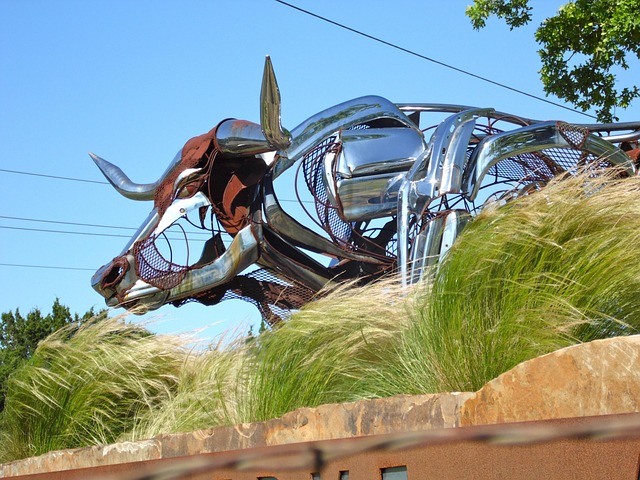Decorative metal art pieces are a versatile and practical addition to any interior style, from mid-century modern to industrial charm and minimalist designs. Their adaptability lies in their ability to complement diverse aesthetics through clean lines, organic shapes, and geometric forms. Strategically placed, these pieces can unite contrasting styles, enhance visual interest, and provide focal points while maintaining the integrity of each design theme.
“Discover the transformative power of decorative metal art pieces in redefining your interior spaces. From the sleek lines of mid-century modern to the raw, industrial aesthetics and minimalist contemporary designs, these versatile sculptures offer a unique way to enhance any style. Explore how metal art adapts to diverse tastes, with examples spanning various genres. Learn about strategic placement techniques, from choosing the perfect size and shape for each room to adding depth and dimension through texture and finish, making your home truly come alive.”
Versatility of Decorative Metal Art Pieces
Decorative metal art pieces offer unparalleled versatility, making them a stunning addition to any interior style. Their ability to seamlessly blend with various aesthetics is a significant advantage for home and design enthusiasts. Whether it’s the sleek lines of mid-century modern or the raw, industrial charm, these sculptures can adapt and enhance each unique setting.
The beauty of metal art lies in its transformative power; a single piece can elevate a minimalist space by adding depth and texture, or complement a contemporary design with its abstract forms and shapes. Their durability and low maintenance make them a practical choice, ensuring they remain a focal point for years to come, while their versatility encourages creative placement, allowing each individual to tell their own unique story through art.
– How they adapt to different interior styles
Sculptures designed to complement a variety of interior styles, from mid-century modern and contemporary to industrial and minimalist, offer a versatile aesthetic that seamlessly blends with diverse decor themes. These decorative metal art pieces are not confined to any single style; instead, they adapt beautifully to suit each unique setting. For instance, in a mid-century modern home, sculptures with clean lines and organic shapes can enhance the warm, natural ambiance while fitting right into the existing design. In contrast, industrial spaces benefit from robust, geometric forms that echo the raw, unadorned walls and ceilings. Minimalist interiors, on the other hand, often embrace sculptures with minimalistic designs, allowing them to stand out as focal points without clashing with the simplicity around them.
The adaptability of these art pieces lies in their ability to complement and contrast with various design elements. Whether it’s the use of neutral tones, bold colors, or natural materials, sculptures can be chosen or crafted to either unify or highlight contrasting features within a room. This versatility ensures that each interior style retains its integrity while gaining a dynamic new element that invites closer inspection and conversation.
– Examples of metal art fitting mid-century modern and contemporary spaces
Metal art has long been a beloved element in interior design, especially for spaces that exude mid-century modern or contemporary aesthetics. Sculptures crafted from metal offer an endless array of styles and forms, allowing them to seamlessly blend with various design themes. For instance, abstract geometric shapes in polished brass or stainless steel can add a touch of elegance and modernity to a minimalist living room, while more organic, flowing lines in weathered steel might enhance the warm, rustic feel of a contemporary bedroom.
These decorative metal art pieces serve as versatile accents, capable of standing alone as focal points or harmonizing with existing decor. They can be integrated into walls, shelves, or even as part of furniture designs, providing both visual interest and textural depth. Whether it’s a sleek, industrial-style loft or a cozy, mid-century-inspired den, the right metal artwork can elevate the overall ambiance, creating an atmosphere that is at once stylish and inviting.
Mid-Century Modern and Industrial Styles: A Perfect Match
Mid-Century Modern and Industrial styles, often considered contrasting interior aesthetics, find harmony through the strategic placement of decorative metal art pieces. The clean lines and natural materials defining Mid-Century Modern design seamlessly blend with the raw, unadorned look of Industrial style when complemented by metallic artwork. Decorative metal art pieces, with their ability to reflect light and add texture, bridge the gap between these two eras. A meticulously crafted geometric sculpture in brushed steel or a minimalist abstract piece in blackened iron can elevate both the warmth of Mid-Century wood finishes and the gritty appeal of exposed brick in an Industrial setting.
– Characteristics of these styles and how metal sculptures complement them
The versatility of decorative metal art pieces is a perfect fit for a range of interior design styles, from mid-century modern to industrial and minimalist aesthetics. Mid-century modern interiors often feature clean lines, natural materials, and a focus on functionality, while contemporary designs embrace bold shapes, vibrant colors, and unique patterns. Metal sculptures complement these styles by adding a touch of industrial edge or abstract elegance, depending on the piece’s design.
In an industrial setting, metal art seamlessly integrates with exposed brick walls, concrete floors, and metallic accents. The raw, unpolished look of many metal sculptures mirrors the industrial aesthetic, creating a cohesive and striking interior. Conversely, minimalist spaces benefit from the negative space and clean lines of decorative metal art pieces, which can serve as focal points without overwhelming the room’s simple, refined vibe.
Decorative metal art pieces offer a versatile and stylish solution for any interior, easily adapting to diverse design aesthetics. From mid-century modern and contemporary to industrial and minimalist, these sculptures seamlessly blend with various themes, enhancing the overall ambiance. Their ability to complement such varied styles underscores their enduring appeal as essential components in modern home decor.
